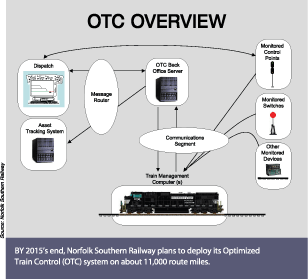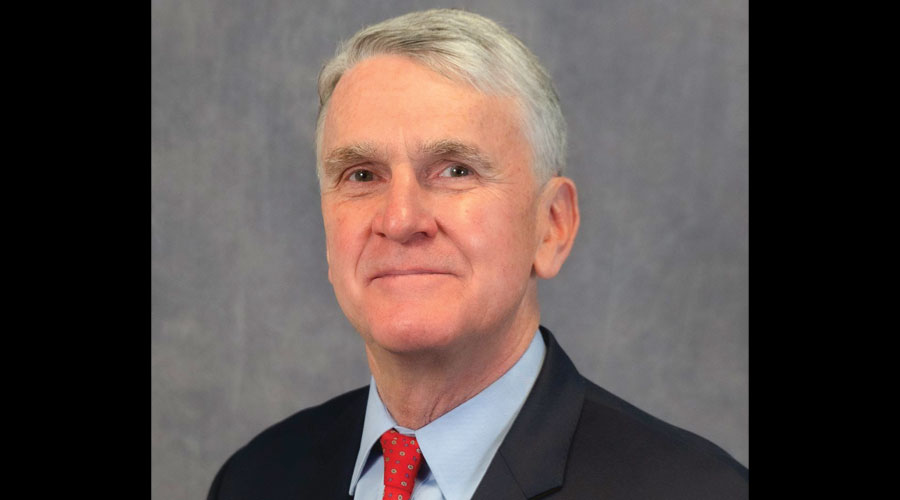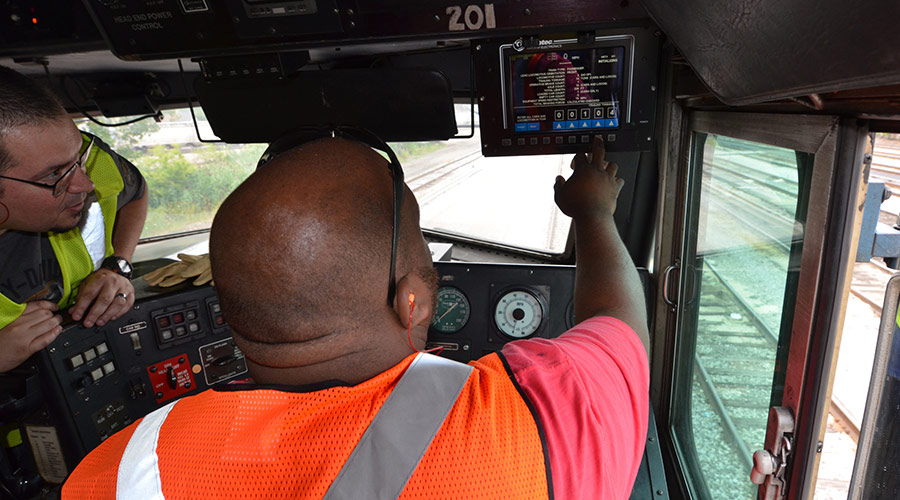Stay updated on news, articles and information for the rail industry
December 2008
Rail News: PTC
Railroads Set Positive Train Contol (PTC) Development & Interoperability Strategies to Meet 2015 Mandate
By Jeff Stagl, Managing Editor
Since the late 1990s, railroads have spent hundreds of millions of dollars to research, develop and test positive train-control (PTC) systems.
Their individual systems read like an alphabet soup, including Amtrak’s Incremental Train Control System (ITCS), BNSF Railway Co.’s Electronic Train Management System (ETMS), CSX Transportation’s Communications-Based Train Management (CBTM), Norfolk Southern Railway’s Optimized Train Control (OTC) and Union Pacific Railroad’s Vital Train Management System (VTMS). No matter the acronym, each system aims to prevent train collisions, enforce train speed limits and protect maintenance-of-way employees working on track.
Now, Class Is, Amtrak and other passenger railroads need to step up their PTC R&D and deployment efforts, including the development of an interoperable system, and collectively spend about $3 billion to $4 billion to comply with a new federal mandate. As stipulated in the rail safety law enacted in October, railroads by 2015’s end must install PTC on all lines used by passenger trains and those used by freight trains to move toxic-by-inhalation hazardous materials — or virtually all mainlines.
 Step No. 1 in meeting the mandate: submitting a PTC implementation plan to the Federal Railroad Administration (FRA) by April 2010.
Step No. 1 in meeting the mandate: submitting a PTC implementation plan to the Federal Railroad Administration (FRA) by April 2010.
But before most railroads do that, they’re seeking answers to a few key questions. What type of PTC system will satisfy the federal mandate since there isn’t an off-the-shelf product to purchase and implement? Are the systems Class Is have been developing robust enough to meet the mandate? What equipment do commuter roads need to purchase? Can a system be developed, tested, approved by the FRA and fully implemented by the 2015’s end? And how will each freight and passenger road fund it all?
“We haven’t determined how we will pay for it,” says UP Assistant Vice President of Transportation System Development Jeff Young. “We estimate PTC will cost us from $700 million to $1 billion.”
For now, there are more questions than answers. And it will take months — or longer — for the feds and railroads to sort it all out.
Money Matters
There is one firm federal option on the funding front. A rail safety law provision calls for each railroad to receive $50 million annually for five years. However, “that’s a drop in the bucket,” says BNSF VP of Safety, Training and Operations Support Mark Schulze, adding that the money will help fund the adoption of several technologies, including electronically controlled pneumatic brakes.
In addition, the freight-rail tax credit the rail industry is pursuing on Capitol Hill might apply toward PTC costs, Class I executives believe. Or the surface transportation reauthorization bill might address the technology, they hope.
As for the query on which technologies meet the mandate, the FRA expects to clear up any confusion soon. In early 2009, the agency plans to adapt a regulation issued in March 2005 — Standards for the Development and Use of Processor-Based Signal and Train Control Systems — for the PTC mandate.
A system will comply if it incorporates PTC’s three safety features and benefits: positive train stop and train speed restrictions to prevent train-to-train collisions and overspeed derailments, and the protection of roadway workers in limits of authority to prevent injuries and fatalities, according to the FRA. That definition rules out cab signal, automatic train stop and a few other systems.
The FRA is working on a draft of the train-control regulation changes and expects to begin discussions on it early next year, says FRA Deputy Associate Administrator for Safety Standards and Program development Grady Cothen.
To meet the mandate’s deadline, railroads will need to complete testing two or three years prior to 2015 to have enough time to get their system approved by the FRA, install it and “have it turned on in the required portions of their network” by Dec. 31, 2015, says Cothen.
“We recognize that this is a very big job,” he says.
The Big Picture
So do the four largest U.S. Class Is, which in October reached an agreement to develop an interoperable system while they pursue their own PTC technology.
“We figure we’ll have to install 20,000 wayside devices and onboard devices on 6,000 locomotives,” says UP’s Young.
Adds NS VP of Operations Planning and Support Gerhard Thelen: “We believe we will install [devices] on 3,000 to 3,500 locomotives.”
Under the interoperability pact, BNSF, CSXT, NS and UP agreed to install wayside PTC systems that operate at a 220 MHz radio frequency. Commuter railroads that operate on the Class Is’ tracks will have to use onboard systems that operate on the same frequency.
All railroads will use a common onboard system — to be developed by Wabtec Railway Electronics — that will feature locomotive cab computers and back-office monitors designed to display the same data in a similar fashion, but differ slightly as vital or non-vital system components. Wabtec might begin testing in second-quarter 2009.
In the meantime, the interoperable system needs to be developed. In October, the Class Is contracted BNSF subsidiary Meteor Communications Corp. to create the Higher Performance Data Radio, which will integrate voice and digital data, and support line-of-road communications for the interoperable system. The large roads expect the system to be developed by late 2009.
The Class Is spent more than nine months hammering out the interoperability pact. CSXT, which has been testing PTC since 1998, initially was concerned the 220 MHz radio frequency would pick up interferences in New York City and, perhaps, other major cities, says Executive VP and Chief Operating Officer Tony Ingram, adding that the Class Is are working to resolve the issue.
CSXT will need to install PTC on 85 percent of its system, he says. The Class I continues to develop and test its CBTM system and likely will first install it along the Interstate 95/Amtrak corridor.
“That way, we can get most of the commuter agencies first, then do Baltimore to Washington,” says Ingram.
NS, which began to develop its OTC vital system in 2005, also has a certain corridor in mind for initial testing and implementation. By 2009’s end, the Class I expects to complete OTC testing on 222 route miles between Charleston, S.C., and Charlotte, N.C., says NS’ Thelen.
“It has all territories in it — non-signaled, signaled, ABS and CTC,” he says.
After testing is completed, NS plans to seek product safety plan (PSP) approval from the FRA. Eventually, the Class I will install PTC on 11,000 route miles.
“There isn’t a lot of slack to meet the mandate, it’s very tight,” says Thelen.
UP is counting on the FRA to accelerate the PSP approval process so Class Is can meet the 2015 deadline. UP plans to seek FRA approval to begin deploying its vital VTMS system in 2010 on lines running through Iowa, Nebraska and Wyoming, and through Idaho and Washington. Testing on the lines, which total 456 miles, likely will continue through 2009.
Like NS, UP wants to test its system on lines that feature different territories, including dark, cab signal, CTC and Automatic Train Control.
“We won’t have to go back to the FRA each time we want to deploy the system in a different territory,” says Young.
By 2012, UP also plans to implement PTC in the Los Angeles Basin area on lines shared with commuter railroads.
BNSF plans to implement PTC on shared L.A.-area lines by 2012, too. If funding is available, the Class I also might implement PTC sooner in other parts of its system, including other shared lines.
Since 2003, BNSF has been developing ETMS with Wabtec. The Class I has been testing the system in revenue service the past two years, including a pilot on a 135-mile Illinois line. BNSF continues to test the system between Fort Worth, Texas, and Oklahoma City, Okla. During more than 1,600 train trips, ETMS has stopped every train it should have and not stopped any train it shouldn’t have, says Schulze.
The interoperable agreement will slightly slow BNSF’s deployment plans, perhaps by one or two years, because the railroad “had a system in place and was ready to deploy,” he says.
While its counterparts continue to move ahead with portions of their implementation plans and the interoperability pact, the Kansas City Southern Railway Co. still is in the process of assessing the new law’s impact, says Doniele Kane, Kansas City Southern’s AVP of communications and community affairs.
Not Quite Good to Go
Ditto for several commuter railroads. California’s Metrolink is determining the cost and deployment implications of the mandate and interoperability pact.
“By the end of February, we expect to have an implementation plan, a good cost estimate and a good date to start building a PTC system incrementally,” says Metrolink Chief Executive Officer David Solow. “We likely will have some version of ETMS or VTMS because we interface with both BNSF and UP.”
Because the two Class Is expect to install PTC wayside devices in the L.A. Basin by 2012, Metrolink will try to equip 57 cab cars and 52 locomotives with onboard devices well ahead of time, perhaps by 2010’s end, he says. The railroad will equip cab cars as they’re replaced and install the devices on all new cars.
In the meantime, Metrolink plans to file for a FRA waiver to install automatic train stop systems at “locations with big speed restrictions,” says Solow, adding that the systems are a temporary measure that won’t provide the productivity and safety benefits PTC affords.
However, Metrolink officials believe the railroad needs an immediate technological boost to prevent train accidents — something the agency hasn’t been able to do of late. In September, Metrolink and UP trains collided in Chatsworth, Calif., and last month, Metrolink and BNSF trains collided in Rialto, Calif. Both accidents were caused by Metrolink engineers who failed to obey red signals, according to preliminary National Transportation Safety Board findings.
Strategic Thinking
Virginia Railway Express (VRE) also is seeking another layer of safety beyond a cab signaling system on a CSXT segment. And like Metrolink, VRE is trying to set its mandate-compliance strategy.
“The question is: What equipment do we buy, and are we buying the right thing?” asks VRE CEO Dale Zehner. “We’re also wondering how a system will deal with overrides to red signals. Sometimes, dispatchers in certain circumstances allow a train to go through a red signal at a restricted speed.”
The interoperability agreement is important to VRE because it interfaces with CSXT and NS, he says. If not for the pact, VRE would need two different onboard devices on each locomotive. VRE will install devices on 41 locomotives at a cost between $1.2 million and $2 million.
“It’s not a showstopper, but a cost we have to contend with,” says Zehner.
For Amtrak, contending with the mandate means continuing to implement PTC in Michigan. The national intercity passenger railroad plans to extend its GE Transportation-developed ITCS system from Niles to the Indiana border, says spokesman Marc Magliari.
Amtrak, which has been using ITCS in revenue service in Michigan since 2002, will continue to assess the mandate’s effects on any other deployment plans.
“Assess” is the word of choice for most railroads when describing their location along the mandate-compliance curve. They know it isn’t just a matter of spending the fewest amount of dollars to acquire PTC equipment and put it in place by 2015’s end. It’s also about investing in developing and deploying the best technology available to ensure their railroads are safer and more productive.
“We’ve got do it right and not just do it,” says Metrolink’s Solow. “There’s talk about a PTC system being 99.99 percent safe, and it’s got to be that.” 
— by Jeff Stagl


 2025 MOW Spending Report: Passenger-rail programs
2025 MOW Spending Report: Passenger-rail programs
 Gardner steps down as Amtrak CEO
Gardner steps down as Amtrak CEO
 Guest comment: Oliver Wyman’s David Hunt
Guest comment: Oliver Wyman’s David Hunt
 Women of Influence in Rail eBook
Women of Influence in Rail eBook
 railPrime
railPrime







